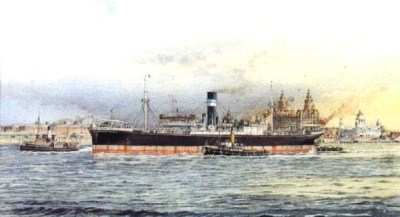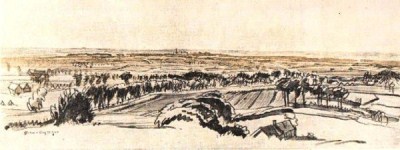The First World War
1914-1920
 The SS Maidan
The SS Maidan
Mobilization
The Liverpool Scottish were mobilised at the outset of war and moved to France on 1st/2nd November 1914, one of the first Territorial battalions to do so. They sailed to France aboard the S.S. Maidan and an account of the time-consuming crossing by a Senior NCO of the Queen's Westminsters (who shared the ship with the Liverpool Scottish) can be found here. At this stage of the war, officers still carried swords on active service.... but not for long! The Battalion was made up from the outset of the war by men of high calibre, educated professionals and businessmen such as Arthur Hopley. During the course of the War, over 600 of its soldiers were to be commissioned and the Museum has carefully researched over 7000 names to yield a fascinating picture of the social composition of The Liverpool Scottish. Details of many of these men can be found in the WW1 history of the Liverpool Scottish, 'Bravest of Hearts', by Hal Giblin with David Evans and Dennis Reeves (Now out of print).
Winter in the Trenches 1914-15
Soon after they arrived in France and Flanders the Battalion reorganised from the 'eight company' system to the Regular Army's 'double company' organisation, numbering its companies from No. 1 to No. 4 and subsequently renaming them (previously A to G) as V, X, Y and Z, possibly a unique lettering system in that it survived until 1999. It entered the front line at the end of November 1914, 26 officers and 829 other ranks strong. By the end of January 1915 following terrible winter weather, the total strength had fallen to 370.
Much of this early period was spent near Ieper (Ypres) and a lithograph by Sir Muirhead Bone of the area between Kemmel and Ieper is shown here. It was published in 1916 but gives a good idea of the open nature of the country.
 Flanders Countryside - View North from near Kemmel to Ypres (Ieper) 1916 - Muirhead Bone
Flanders Countryside - View North from near Kemmel to Ypres (Ieper) 1916 - Muirhead Bone
A Distant View of Ieper (Ypres) from the South West This view of the Flanders landscape (executed in 1916 by Muirhead Bone, a war artist who was later knighted, for the series published as a part work by Country Life magazine) is from a viewpoint 'some six miles south west of Ypres. The ruins of the Cloth Hall tower can be seen in the centre, the village of Hooge (not seen) is a little to the right and Zillebecke further to the right. The artist tells us that Dickebusch (modern spelling Dikkebus) is midway between the viewpoint and Ypres. This would mean that the observation point is somewhere in the region of the village of Kemmel, perhaps on the KEMMELBERG. The high ground on the horizon, represents the German positions in 1915, which swung in an arc round the ancient city of Ieper (Ypres) and created 'The Salient', a bulge in the British line dominated by the encircling Germans on the crescent of high ground.
Battle of Hooge (First Action at Bellewaarde)
The first major battalion action of the Liverpool Scottish was on 16th. June 1915 in what is officially known as 'The First Action at Bellewaarde', but is known in The Liverpool Scottish as 'The Battle of Hooge'. Hooge is a village is a few miles East of Ieper (Ypres), straddling the Menin Road. The Liverpool Scottish, as part of 9th Brigade, were to take part in the second phase of the attack on ground just north of the Menin Road. the battalion strength was 24 officers and 519 men. Initail reports after the attack show only 2 officers and 140 men unscathed, 4 officers and 75 men killed and 11 officers and 201 men missing. Official figures for the loses sustained by the Battalion were 150 killed, but many others of the wounded were evacualted back the the Uk.
Originally the Territorial Force had been intended to form seperate Divisions with their own artillery and support services. However the pressure on the regular army meant that at first individual units were slotted into regular Divisions and Brigades. Pressure however from various sources however eventually allowed for the Territorial Forces' Divisions to be formed. The Liverpool Scottish became part of the The 55th (West Lancashire) Division. The Divsion was formed in January 1916 and initally, as note in his diary by Colonel Davidson, the 55th Division was seriously understrength. These shortages where made good during the spring and early summer of 1916. The battalion as part of the 55th Division fought in the Battle of the Somme at Guillemont.
As part of the Centenary Commemorations Major I.L. Riley has written a series of articles recounting the experience of the Territorial Force during the First World War. An article on the reforming of the 55th and its training can be found here. A further article on the Division's actions on the Somme can be form here.
Other Great War Battalions
The 2/10th (Scottish) Bn The King's (Liverpool Regiment) served in France and Flanders from February 1917 until its amalgamation with the 1st Battalion in Spring 1918 during the "Manpower Crisis".
For much of 1917 they served in the Bois Grenier Section near Armentières with their operating base in the small town of Erquinghem some few kilometers to the west. Although a relatively quiet sector of the front, there are 45 Liverpool Scottish graves in Erquinghem Churchyard Extension Cemetery, maintained by the Commonwealth War Graves Commission. In all there are 680 graves in this churchyard.
Select the 2nd battalion from the menu or click on the heading above to read their story.
A third battalion (3rd/10th) formed in 1915, based for most of the war at Oswestry, acted as a draft finding and training battalion.
Previous page: The Volunteer Force and the Territorial Force
Next page: Mobilization